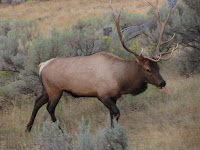 *Critters we’ve seen on our 2011 trip so far: yellow-bellied marmot, mule deer, bison, moose, pronghorn antelope, elk, coyote, beaver, black bear, grizzly, bighorn sheep
*Critters we’ve seen on our 2011 trip so far: yellow-bellied marmot, mule deer, bison, moose, pronghorn antelope, elk, coyote, beaver, black bear, grizzly, bighorn sheep
*Birds we’ve seen on our 2011 trip so far: mountain bluebird, golden eagle, Indigo bunting, Lazuli bunting, Say’s Phoebe, yellow-rumped warbler, Western Tanager, bald eagle, blue heron, American white pelican, trumpeter swan, osprey, magpie, mountain bluebird, Clark’s Nutcracker
Over the next few weeks we were once again tourists enjoying the sights of Yellowstone. Though we’ve visited many of the same areas in previous trips, we never tire of experiencing the many wonders of this incredible national park. We took a couple more trips out to Lamar Valley and were lucky enough on one of those

trips to spot 7 wolves and pups! We also toured the Mammoth Terraces, Norris Geyser Basin, Calcite Springs, Grand Canyon of the Yellowstone, and Tower Falls just to name a few. And as we walked to the Tower Falls overlook, we passed this jaw bone right next to the walkway!

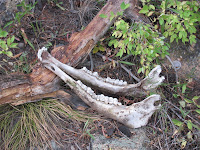
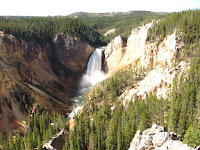


One thing we’ve learned on our travels is that glaciers can move boulders great distances, and about 20,000 years ago this huge boulder was moved more than 15 miles from the Beartooth Mountains to its current location near Inspiration Point in the Canyon area! And on our way back we noticed several

people pulled off to the side of the road with cameras pointed up the hill, and there was this darling coyote hunting for some small varmint hiding in the brush.
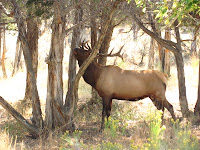
As you know, our main reason for hanging out longer in the Mammoth area was to experience the elk rut (mating season) since they breed in the fall. Bulls will gather cows (females) and calves into small groups known as harems, and will aggressively protect these harems from othe

r bulls by running them off, thrashing their antlers against the ground and trees in a show of aggression, and if need be, butting heads. The bull’s antlers are at their largest by this time of year, and are a sign to the cows of their quality and virility. They will wallow in mud to not only cool off their over-heated bodies b

ut to make themselves appear more imposing, and will also spray themselves with urine sort of as a “perfume” that is attractive to the cows. When the rut begins, the bulls begin to bugle. This not only announces their presence to other males but also gives a cow cl
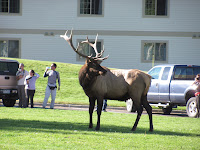
ues to his size and strength, important factors in determining who will produce the best offspring. The vocal range of their bugle varies with the individual and their maturity level, and is one of the most amazing sounds. When the cows come into heat, the mating begins (not that the bulls won’t try sooner!) A bull has to be ready because the cow is receptive for mating less than 24 hours and won’t be willing to mate again until her next cy
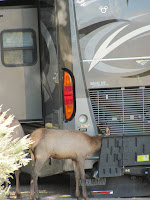
cle in about 20 days. They can have up to 4 of these cycles in a season but usually become pregnant fairly quickly.
Several groups came through the campground on a daily basis, generally a couple times a day, sometimes even bedding down in the meadow area for several hours or simply grazing as they passed the many campers trying to get the perfect photo. As a matter of fact, we’ve had

3 bulls of varying sizes with their harems in the campground all at the same time. And like the bison, it is their park and they move where they want when they want. In fact we came home one day from watching the elk up the hill in town and were unable to get to our RV because it was surrounded by cows and calves! So we just hung o

ut in the car in the middle of the road until the bull decided to herd them along.
We saw lots of posturing by the bulls, some chasing of one another, and lots of bugling but never saw any of the head-to-head battles. However we did get to see some actual mating a couple of times (or at least attempts). As we were driving through the campground one day, we came upon a group h

anging out partly in the road, partly in the meadow, and stopped to take some photos. Well, lo and behold, one of the cows must have let this bull know she was in a receptive mood, and I got quite the shot! (Hope no one is offended by this act of nature I captured!) What I didn’t realize until after I took the picture was the sign in the background…obviously he hadn’t read it!! LOL

If you’d like to learn more about the elk and their habits, the website for the Rocky Mountain Elk Foundation (
http://www.rmef.org/AllAboutElk) is a great source of information.
Our original plan had been to stay in the Mammoth area until the snow forced us to leave, but with the repair work needed on the RV, it was time to move south to Salt Lake City once the parts had arrived.

1 comment:
Read your newest blog. Enjoyed the picture of the bull in his obvious position and especially the sign...they should learn to read. Donna
Post a Comment